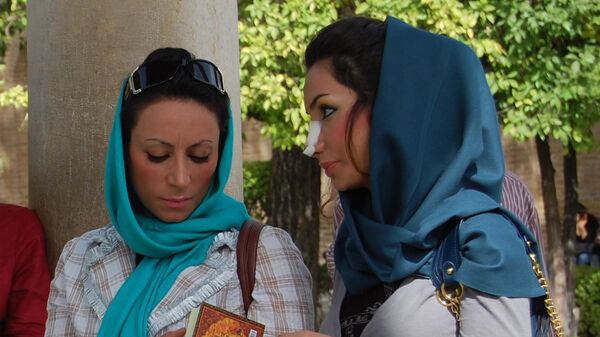Imagine Every Woman’s a Nun



The days when the Shah's men boasted that Iranian miniskirts were shorter than those in Paris are clearly long gone. In today's Iran, modesty rules, and the dress and behavior of women are carefully controlled.
While things are casual at home, Iranian women are expected not to show their hair or the shape of their body in public. That means covering everything except the face and hands. There are two key components to traditional dress: The hijab ("hih-JOB") is a head scarf. The chador ("shah-DORE") — often simply called "the veil" — is a head-to-toe black cloak wrapped around the front and over the head. (It also might be accompanied by an actual veil.) All women must wear a hijab, and many older, rural, and traditional women also wear a chador.
In addition to the dress code, Iranian women face other limitations. They're relegated to separate classrooms and sections in mosques. They are not allowed to attend soccer games (for fear that they might overhear some foul language from the impassioned fans). And on public transportation, they ride at the back of the bus, or in a special, separate train car on the subway.
From a Western viewpoint, it's disrespectful (at best) to impose these regulations on women. But from a Muslim perspective, it's the opposite: Mandated modesty is a sign of great respect. In the Islamic Republic of Iran, women's bodies are not vehicles for advertising. You don't see sexy magazines. There is almost no public display of affection. In theory, the dress code provides a public "uniform," allowing men and women to work together without the distractions of sex and flirtation.
Still not buying it? You're not the only one. Local surveys indicate that about 70 percent of these women would dress less modestly in public, if allowed. Many are already easygoing about their dress. In filming, I found the women's awareness of our camera fascinating — women seemed to sense when it was near, and would adjust their scarves to be sure their hair was properly covered.
While modesty is enforced, vanity is not out of bounds. Women still utilize their feminine charms. In a land where cleavage is essentially against the law, a tuft of hair above the forehead becomes the exciting place a man's eye tends to seek out. Cosmetic surgery — especially nose jobs — is big business here among those with money. Faces are beautifully made up, and — when so much else is covered — can be particularly expressive and mysterious. I was impressed by the eye contact.
Trying to grasp Iran's mandated modesty in Christian terms, I imagine living in a society where every woman is forced to dress like a nun. Seeing spunky young Muslim women chafing at their modesty requirements, I kept humming, "How do you solve a problem like Maria?"

